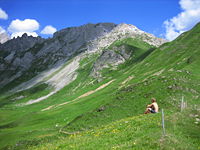Felix Hol: Difference between revisions
From Santa Fe Institute Events Wiki
No edit summary |
No edit summary |
||
| Line 17: | Line 17: | ||
[of course more will follow, but two ideas:] | [of course more will follow, but two ideas:] | ||
While browsing through what the CSSS faculty actually work on, I found out about the work of Iain Couzin on collective animal behavior. This made me think of vortexes and other modes of collective swimming that bacteria show under certain circumstances (e.g. high density). I'll formulate my ideas a little more thoroughly later; but I think it would be interesting to see whether the models describing the motion of for example fish schools would explain something about the collective motion of bacteria. Is there be a big role for chemotaxis, is it hydrodynamics...? | While browsing through what the CSSS faculty actually work on, I found out about the work of Iain Couzin on collective animal behavior. This made me think of vortexes and other modes of collective swimming that bacteria [http://openwetware.org/images/b/b1/Video_RP437pGFP_Peter_Galajda.avi show] under certain circumstances (e.g. high density). I'll formulate my ideas a little more thoroughly later; but I think it would be interesting to see whether the models describing the motion of for example fish schools would explain something about the collective motion of bacteria. Is there be a big role for chemotaxis, is it hydrodynamics...? | ||
As (very briefly) described in the interests section I would also like to work in the influence of population structures on the performance (evolution) of a genetic algorithms. | As (very briefly) described in the interests section I would also like to work in the influence of population structures on the performance (evolution) of a genetic algorithms. | ||
Revision as of 09:22, 25 May 2010

Hi everybody! My name is Felix Hol, I am a PhD student (biophysics) in the labs of Juan Keymer and Cees Dekker at the Kavli Institute of BioNanoscience, Delft university of technology (the Netherlands).
Main Interests
Among many other things, I am interested in and currently work on the role the spatial distribution of populations has on determining evolutionary computation in two separate systems: (1) metapopulations of bacteria adapting to dynamic landscapes of antibiotic challenges, and (2) metapopulations of genetic algorithms adapting to perform a classification task.
In my experimental work with bacteria, I observe metapopulations adapting on-chip to temporal and spatial fluctuations of antibiotics; I compare the behavior of a single, monolithic population in a single homogeneous habitat versus a spatially structured heterogeneous metapopulation. I compare them in terms of their adaptability to the landscape, their robustness, and the rate at which evolutionary innovation confers antibiotic resistance on the cells.
In the computational part of this work I implement genetic algorithms with different population structures (monolithic and distributed metapopulations) to evolve cellular automata task-performing rules. I think this maybe could be a nice CSSS project...
Project ideas
[of course more will follow, but two ideas:]
While browsing through what the CSSS faculty actually work on, I found out about the work of Iain Couzin on collective animal behavior. This made me think of vortexes and other modes of collective swimming that bacteria show under certain circumstances (e.g. high density). I'll formulate my ideas a little more thoroughly later; but I think it would be interesting to see whether the models describing the motion of for example fish schools would explain something about the collective motion of bacteria. Is there be a big role for chemotaxis, is it hydrodynamics...?
As (very briefly) described in the interests section I would also like to work in the influence of population structures on the performance (evolution) of a genetic algorithms.
